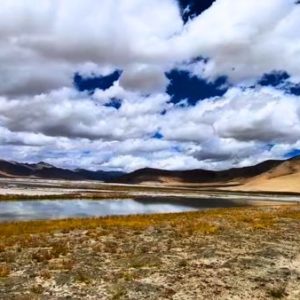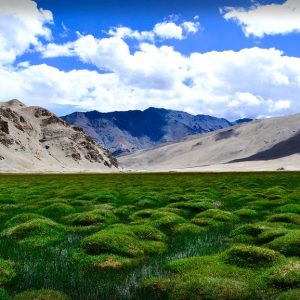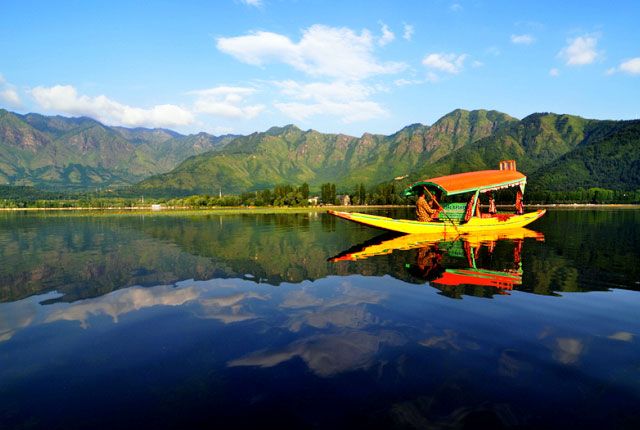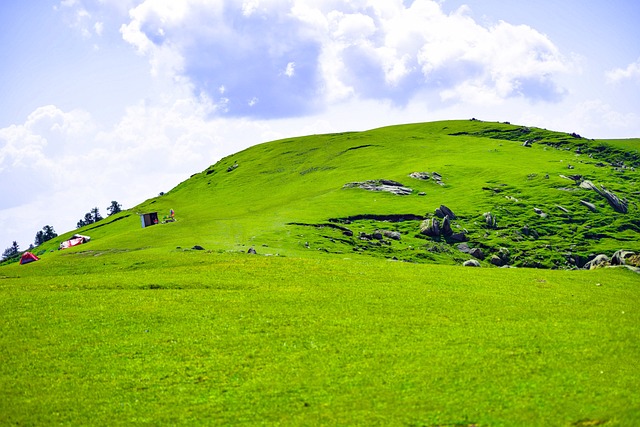
Puga Valley, Ladakh : The Hidden Wonderland of Geothermal Marvels
Table of Contents
ToggleOverview
Puga Valley is another region within Ladakh that is little known and is often terribly overlooked by travelers. However, Puga Valley completely stands out when it comes to blending the geothermal wonders of Ladakh. Unlike Puga Valley, the Puga Valley is known for unique geomorphology, geothermal hot springs and crystal clear blue skies along with undulating mountains, and the dense culture of its natives.
Hot and dry landscape regions of below 5000m height, deep valleys, and hot springs are ideal for adventurists in winter, and this place becomes a sanctuary of wildlife. This blog highlights the majesty of Puga Valley’s natural features, geothermal marvels, and some handy tips for tourists and visitors.



Explaining Puga Valley
Puga Valley is an isolated valley located east of Ladakh, along the border of China, which is roughly 140 kilometers from Leh town. It has a unique geothermal landscape with barren plains, geothermal springs, salt flats and sulfur deposits. Puga Valley is a part of the Ladakh Plateau which lies at an elevation of nearly 4000 meters above sea level. This geomorphic setting provides an opportunity for the tourists to enjoy the desert mountains and splendid beauty of region.
Although still off the beaten path, Puga Valley is particularly important for consultants and researchers interested in geology, remote areas, thermal waters, and stunning landscapes. Due to its border position Puga Valley serves as a gateway for the travelers passing by whose journey’s purpose is to reach Pangong or Tso Moriri Lake. It is a great starting point for tourists willing to discover the secret side of Ladakh.
Wonders of Geothermal Activity – Puga Valley
Geothermal springs are one of the most defining features of Puga Valley. The valley contains an abundance of hot springs, which are uncommon in the drought-stricken region of Ladakh. The geothermal springs within this region are beautifully distributed throughout the valley, and the Puga hot springs are certainly the most prominent. The hot springs of this region have an abundance of minerals, such as sulphur, which give the springs their distinctive odor, and hot springs are known to possess the properties of healing the sick.
Geothermal activity in Puga Valley does not only include the variety of hot springs. The area is also known to have sulfur deposits, which have been extracted for a number of years. The geothermal resources of Puga are effective in many other areas, including the use of its heat for scientific purposes and possible energy production. The presence of these geothermal phenomena make the valley a crucial location for both eco tourists and geologists.
Like other destinations renowned for their hot springs, the sulfuric springs of Puga Valley are said to have therapeutic properties and are well known for their mineral rich waters, especially for skin diseases, pain in joints, and relaxation of muscles.
Natural Wonders and Sights of Attraction
Besides Puga Valley’s geothermal marvels, it is also an area of astounding beauty. Its plains are often punctuated by additional green patches, forming a stark contrast that creates strikingly beautiful scenery. Its varying colors, during day time, makes the lands a delight for any photographer.
- The Salt Flats
Puga Valley’s salt flats are possibly the most beautiful features of this valley. When viewed from a far distance, these massive, white areas of crystallized salt have an almost extraterrestrial look. Not only are these salt flats beautiful, but they also serve as a home for numerous creatures including migratory birds such as the bar-headed goose. There is a uniquely beautiful harshness about the region that is unlike anything else, it’s predominately wedged between the towering salt flats and rich colored surrounding hills.
- Verdant Spots
Even though most of Puga Valley is a dry, barren, desert-like stretch, there are some distinctive spots within the valley that are covered with green patches. These regions recieve water supply from the nearby geothermal hot springs, and the warm soil is suitable for living organisms to survive in the otherwise hostile environment. These green patches also serve as the grazing grounds for a few nomadic herders who tend to their yaks and sheep in this desolate area.
- Viewing The Glaciers and Mountains
A cluster of high mountain ranges that enclose Puga Valley forms its bounding. These mountains are a magnificent sight on their own. Their snow-covered tops serve as an ideal subject for photographs. Together with the fresh and unpolluted air in Puga Valley, the beauty of the surrounding mountains is magnified. This allows tourists to enjoy the stunning views of the hard terrains of Ladakh which is unmatched.
- Flora and Fauna Found in Puga Valley
The salt flats and wetlands located in the Puga Valley area have become a hotspot for many migratory birds and wildlife experts. Even though the region is sparsely inhabited, Puga Valley is populated by a variety of wildlife that includes snow leopards and the critically endangered Tibetan wild ass (Kiang) among other species. People excited for an adventure may go birdwatching and with a little luck, spot some rare wildlife.
Recreational Pursuits in Puga Valley
Off the main tourist path, Puga Valley offers a sense of peace and seclusion that is ideal for adventurists looking for a break. It is evident that the local terrain is ideal for several outdoor pursuits:
- Hiking and Trekking
Puga Valley has great potential for hiking because of the wide open plains. In comparison to other regions of Ladakh, Puga Valley is not as well known for trekking. However, the wilderness and remoteness of the area is perfect for people looking for tranquility after a long walk.
Scenic Puga Valley boasts hidden monasteries, charming little villages, and lovely streams set against a backdrop of rocky hills and wide meadows filled with wildflowers and diverse landscapes to keep the adventurous spirit.
- Photography
With unique scenery, such as the salt flats and snow caps, Puga Valley is a treasure chest for photographers. The region’s light and colors during various times of the day provide chances to capture images for every single moment throughout the day. Be it thermal spring photography or capturing local fauna, Puga Valley is a photographer’s paradise.
- Wildlife Watching
Puga Valley is heaven for wildlife lovers as it provides an opportunity to spot the most unique bird species and animals in Ladakh. The salt flats and wetlands region is in fact a great destination for bird watchers as migratory birds frequently stop by during colder months. Scenic views include the sight of a Tibetan wild ass (Kiang) feeding in the velvety meadows, along with marmots and snow leopards sprawled in the distant mountains.
Cultural Identity And People
Due to its remoteness, Puga Valley has a very low population with only some nomadic herders residing in the area. People here live under extreme conditions and therefore, their main are reliant on livestock farming especially yaks and sheep. The stunning environment of the valley is harsh, and due to this the valley inhabitants tend to nomadic lifestyles.
Tibetan Buddhism is the main religion of the valley, influencing the native culture with the presence of small monasteries scattered across the region. Due to lack of outside access, this region retains much of its ethnological lifestyle. While traveling to the Puga Valley, people have a chance to meet the locals, understand the region’s cherished traditions, and observe their unchanged way of life for the past centuries.
Warm and welcoming, people from Puga Valley are easy to deal with. One can partake in cultural activities by living with native people or visiting the innumerable stalls. The secluded character of the valley guarantees the retention of the customary way of life of the ladakhis, hence, providing travelers an insight into a calm and simpler life.
Travel Information for Puga Valley
Traveling to Puga Valley requires some forethought due to Puga Valley being in the remote section of Ladakh. Leh is the closest major town which is accessible by road and air travel. Once in Leh, one can always catch a taxi or even a shared jeep that costs lesser. It takes about 6-7 hours for the journey to Puga Valley.
Though there are no flights to Puga Valley, travelers can reach Leh Valley and hire a local taxi to the Puga Valley. Likewise, there are some of the most beautiful drives in Ladakh that offer breathtaking views, such as the Khardung La Pass turning into a scenic road trip.
Visit Puga Valley from May to Puga Reaches its Peak in September
Visiting Puga Valley during the May to September range is the most ideal since the temperatures improve and the roads are more accessible. This is the peak tourist season in Ladakh, and since Puga Valley is off the beaten path, it tends to be more relaxed than other popular destinations. Puga Valley does tend to be quieter while still experiencing tourist inflow.
In the months of October through March, the valley is supremely cold with temperatures around or below freezing. Add snow-covered roads and the winter months could be unsuitable to visit unless willing to endure extreme weather conditions.
Travel Tips for Visiting Puga Valley
- Altitude Sickness: Travelers are recommended to spend some days in Leh before venturing into the valley as Puga Valley is at a relatively high altitude. Spending time in Leh will ensure that the traveler does not suffer from altitude sickness, making their trip easier and more enjoyable.
- Clothing: The weather in Puga Valley is very unpredictable and changes very rapidly. It is best to pack warm clothes even during the summer months for evenings and nights of the valley.
- Permits: Puga Valley does not require special permits, but make sure to check with local authorities if you want to visit nearby restricted areas. Prior to embarking on your journey it’s a good idea to gather information about any permits that are needed because most of the time they are not needed.
- Local Interaction: Be considerate of the customs and traditions when talking to the nomadic herders or monks. Ladakhi people are very warm and friendly, so adopting a friendly demeanor will make sure that they stay positively hospitable towards you.
Conclusion
Noted for its geothermal features, stunning landscape, and rich culture, Puga Valley is a hidden jewel in Ladakh. It is suitable to visit for those who want to see the lesser known places of Ladakh because its landscape, geothermal springs, and salt flats are exceptional and breathtaking. Every traveler’s need is fulfilled, whether adventurous, seeking solitude or a photographer, Puga Valley has unparalleled experiences to offer. If you are making a trip to Ladakh, be sure to add this gem to your itinerary; you will not be disappointed.
How to book Ladakh tour?
Contact a travel agency that specializes in Kashmir tours. You can reach out to the following for assistance:
- Phone:
- +91 7889 655596
- +91 7006 891267
- Email:
Inquire about tour packages, itineraries, and pricing, and confirm your booking for a memorable winter experience!
People Also Ask
What is Puga Valley known for?
Puga Valley in Ladakh is famous for its geothermal activity, hot springs, and unique landscapes. It is a high-altitude desert valley surrounded by mountains, offering a glimpse into the natural wonders of Ladakh.
How do I reach Puga Valley from Leh?
Puga Valley is located about 130 km from Leh, and the easiest way to reach it is by road. You can hire a taxi or join a guided tour that will take you along the Leh-Manali Highway, passing through Changla Pass and other scenic locations.
When is the best time to visit Puga Valley?
The best time to visit Puga Valley is during the summer months, from May to September, when the weather is milder and roads are accessible. Winter months can be extremely cold and challenging to travel in.
What are the main attractions in Puga Valley?
The main attractions in Puga Valley include the geothermal hot springs, the rich sulfur deposits, scenic views of the surrounding mountains, and the unique landscape that makes the valley so special.
Can you take a dip in the hot springs at Puga Valley?
Yes, you can take a dip in the hot springs at Puga Valley, but it’s advisable to exercise caution. The water is hot, and it’s important to check the temperature before entering to avoid burns.
What is the significance of the geothermal springs in Puga Valley?
The geothermal springs in Puga Valley are significant for their unique geothermal activity and mineral-rich water. The valley is a source of sulfur, which is used for various medicinal and industrial purposes.
Is it safe to travel to Puga Valley?
Yes, Puga Valley is generally safe for tourists. However, since it’s located at a high altitude, proper acclimatization is essential to avoid altitude sickness. It is also recommended to travel with a guide, as the valley is remote.
What wildlife can be found in Puga Valley?
Puga Valley is home to some wildlife, including species such as the Tibetan wild ass (kiang), marmots, and various birds like the Himalayan griffon. However, the area is primarily known for its geothermal features rather than abundant wildlife.
How long does it take to reach Puga Valley from Leh?
It takes approximately 4 to 6 hours to reach Puga Valley from Leh, depending on road conditions and the number of stops along the way.
Are there any accommodations in Puga Valley?
Puga Valley itself has very limited accommodations. Most tourists prefer to stay in Leh or nearby towns and take day trips to Puga Valley. However, camping options might be available for adventure seekers.
What is the climate like in Puga Valley?
Puga Valley has a cold desert climate with hot summers and freezing winters. The valley experiences extreme temperature fluctuations, with hot days and chilly nights during summer, and very low temperatures during winter.
Can I visit Puga Valley in winter?
Yes, you can visit Puga Valley in winter, but the extreme cold can make travel difficult, and the roads might be blocked due to snow. It’s best suited for those who are prepared for winter adventures and want to experience the valley’s serene winter beauty.
Is there any mobile network coverage in Puga Valley?
Mobile network coverage in Puga Valley is limited or non-existent, especially in remote areas. It’s a good idea to inform someone of your travel plans and carry a satellite phone if you’re venturing deeper into the valley.
What are the best activities in Puga Valley?
The best activities in Puga Valley include exploring the geothermal springs, photography of the unique landscapes, and experiencing the peaceful isolation of the valley. Trekking and camping are also popular for adventure enthusiasts.
How is the road condition from Leh to Puga Valley?
The road from Leh to Puga Valley is generally good, but it can be bumpy and challenging in some sections. The route passes through high mountain passes, so it’s essential to be prepared for winding roads and varying road conditions.
What is the significance of sulfur in Puga Valley?
Sulfur is a key component of the geothermal activity in Puga Valley. The valley is rich in sulfur deposits, which are used for industrial and medicinal purposes, including the production of sulfuric acid and other chemicals.
Can I visit Puga Valley as part of a guided tour?
Yes, you can visit Puga Valley as part of a guided tour. Many tours include Puga Valley as a stop along with other Ladakh attractions, offering a more comprehensive experience of the region.
Are there any health precautions to consider before visiting Puga Valley?
Before visiting Puga Valley, it is essential to acclimatize properly due to the high altitude. Travelers should also stay hydrated and protect themselves from sun exposure, as the region can get very hot during the day despite the cold temperatures at night.
What is the best way to explore Puga Valley?
The best way to explore Puga Valley is by hiring a local guide who can help navigate the valley’s remote terrain and explain its geothermal features. Many visitors also prefer exploring the valley by car, though trekking is also an option for the adventurous.
How high is Puga Valley?
Puga Valley is located at an altitude of around 4,400 meters (14,436 feet) above sea level, making it a high-altitude destination in Ladakh.
Can you visit Puga Valley as a day trip from Leh?
Yes, Puga Valley is accessible as a day trip from Leh. However, since it takes several hours to reach, it is best to start early in the day to make the most of your time in the valley.
What should I pack for a trip to Puga Valley?
Essential items to pack for a trip to Puga Valley include warm clothing, sunscreen, sturdy shoes, and a camera for capturing the breathtaking landscapes. If you plan to visit the hot springs, consider bringing swimwear or towels.
Are there any eco-friendly initiatives in Puga Valley?
Due to the valley’s delicate natural environment, there are some eco-friendly initiatives in the region to protect its geothermal resources and minimize pollution. Visitors are encouraged to respect local conservation efforts.
Can I do a photography tour in Puga Valley?
Yes, Puga Valley offers excellent opportunities for photography, especially for landscape photographers. The geothermal springs, surrounding mountains, and unique terrain make it a visually stunning location for photo tours.
Is there any local food available in Puga Valley?
There are limited food options available in Puga Valley itself. Travelers typically bring packed meals or stop for food in Leh or other towns on the way to the valley.
What is the terrain like in Puga Valley?
The terrain of Puga Valley is a mix of barren, rocky landscapes with patches of grasslands. The valley is surrounded by snow-capped mountains, creating a dramatic and remote atmosphere.
How can I ensure a safe trip to Puga Valley?
To ensure a safe trip, make sure to acclimatize properly, carry sufficient water, food, and medical supplies, and travel with a reliable guide or as part of a tour group. Always check weather and road conditions before departure.
What kind of transportation is available to Puga Valley?
Private vehicles, taxis, or organized tours are the best modes of transport to reach Puga Valley. It’s recommended to travel in a 4×4 vehicle due to the rough terrain.
Are there any spiritual or religious sites in Puga Valley?
Puga Valley is primarily known for its natural beauty and geothermal features. While there are no major spiritual or religious sites directly in the valley, Ladakh itself is home to many important Buddhist monasteries and religious landmarks nearby.
What precautions should I take while visiting the geothermal springs?
Visitors to the geothermal springs should be cautious about the water temperature, as it can be very hot. It’s important to avoid staying too long in the hot springs and to check water temperature before entering to prevent burns.




